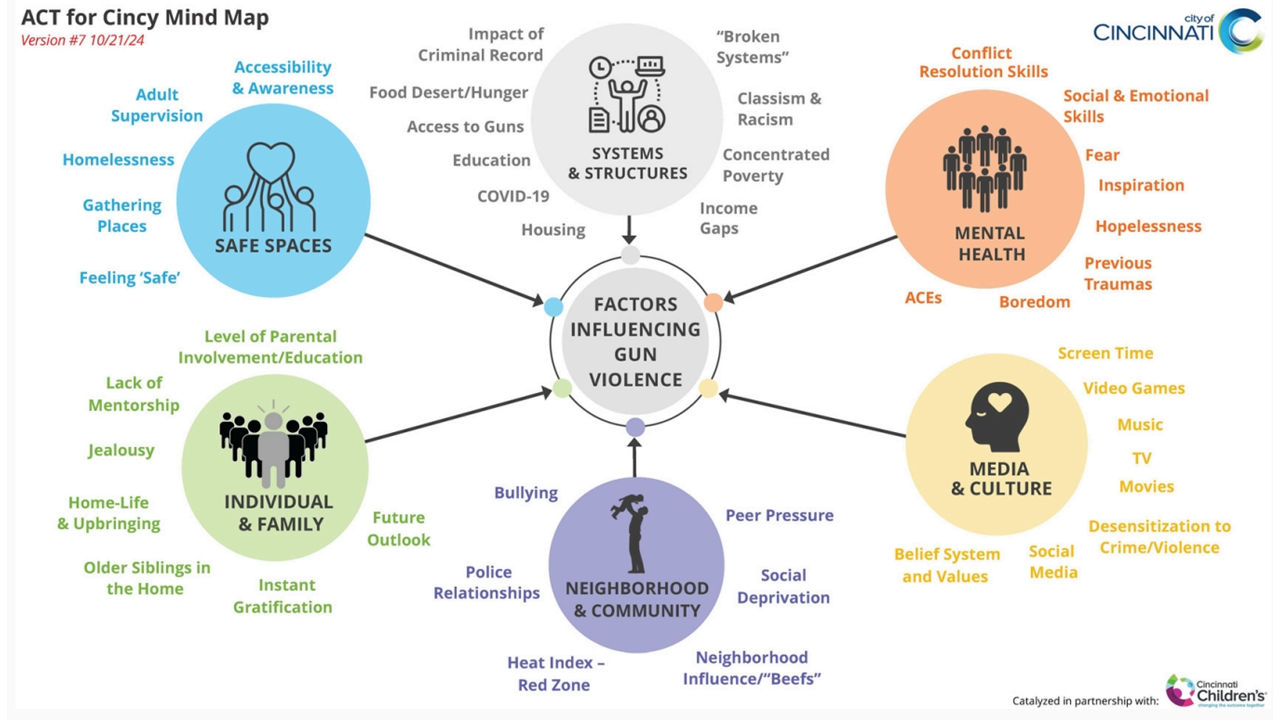Theory of Change
Research
Our theory of change was developed over the last year in concert with the community, community-based organizations, and facilitating partners from Cincinnati Children’s Michael Fisher Center for Child Health Equity. The City’s theory of change was directly informed by a series of dedicated focus groups and multiple community facing meetings that built a ‘mind map’ as well as a ‘causal loop map’ that capture factors that the community has identified as directly causing and influencing gun violence in Cincinnati:

A causal loop diagram is a tool that allows us to depict the interactions between many different factors that are driving gun violence. The blue arrows demonstrate connections where the first item causes an increase in the second item. The red arrows demonstrate connections where the first time causes a decrease in the second item.
Within the entire map there are also smaller loops. Those smaller loops can be reinforcing (depicted by R), meaning that each factor increases the next and as a result the loop reinforces itself. The smaller loops can also be balancing (depicted by B), where each factor may decrease others in the loop and so the loop balances itself out. Significant delays in the loop are identified with two slash marks (||) through a connecting line.

Key Findings
Root Cause Factors Leading to Gun Violence | The community identified several interconnected root causes of gun violence, including poverty, lack of access to quality education, limited employment opportunities, and inadequate mental health resources. These systemic issues create a cycle of disadvantages that make communities more susceptible to violence. The causal loop map developed during the sessions highlighted how these factors are compounded by historical inequities and social determinants of health, underscoring the need for comprehensive interventions that address both immediate and underlying causes.
Community Trust and Engagement as Critical Components | Focus groups emphasized that trust between the community and law enforcement, as well as other city agencies, is vital for any successful violence reduction strategy. Many community members expressed that traditional, enforcement-based approaches without community collaboration have historically exacerbated tensions and hindered progress. Building community trust through transparency, collaboration, and culturally responsive practices emerged as a key priority, as this approach fosters a more cooperative environment for implementing violence prevention initiatives.
Youth Engagement and Opportunity Creation | One of the most recurrent themes was the importance of investing in youth as a preventative measure against gun violence. The lack of accessible, positive outlets for young people—such as recreational programs, job training, and mentorship opportunities—was identified as a major contributor to the cycle of violence. The community and stakeholders agreed that a proactive approach that provides youth with pathways to education, career development, and personal growth is essential. This focus on youth engagement not only addresses an immediate need but also helps build a long-term foundation for reducing gun violence.
